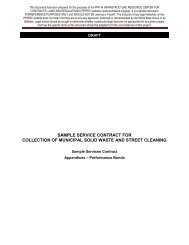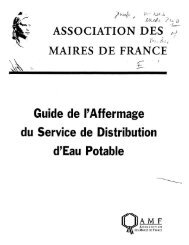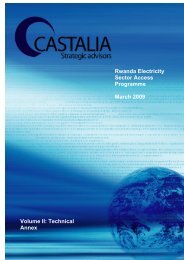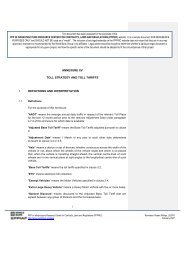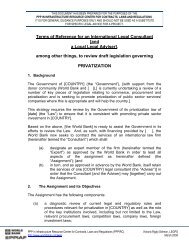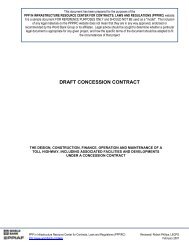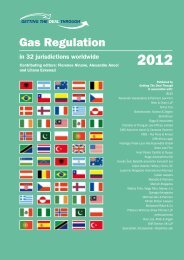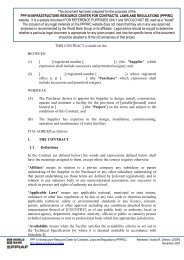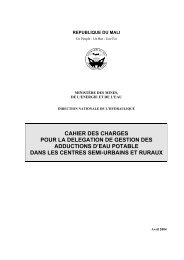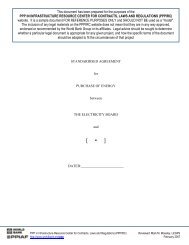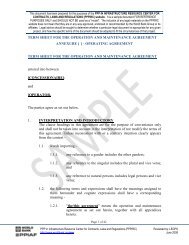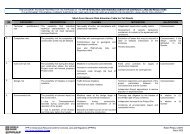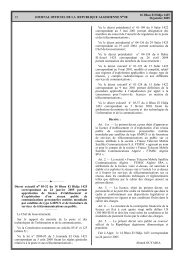Volume I: Investment Prospectus Rwanda Electricity Sector Access ...
Volume I: Investment Prospectus Rwanda Electricity Sector Access ...
Volume I: Investment Prospectus Rwanda Electricity Sector Access ...
- No tags were found...
You also want an ePaper? Increase the reach of your titles
YUMPU automatically turns print PDFs into web optimized ePapers that Google loves.
There are three sources of funds for the electricity sector: customer payments, Governmentsubsidies and contributions from development partners. For the power sector to befinancially viable, the entire funding needs of the sector—which include both capital andoperating costs—must be able to be covered from these three sources of funds.The Government has prepared an initial analysis of how total sector funding needs over thenext five years (2009–2013) will be met from the three major funding sources:• Funding needs—The total funding needed to meet operating costs and achievethe Government’s sector plans for new generation and transmission investmentand the access programme is estimated to be US$875 million, an average ofUS$175 million per year• Funding sources—In its new energy sector policy the Government has statedthat, at a minimum, operating costs should be met through operating revenues.Additional funding will then be provided through Government contributions anddevelopment partners to meet the capital costs of the access programme andinvestments in generation and transmission capacity. The Government proposes asustainable financing framework for the electricity sector that will see 10 percentof the capital costs of new grid extensions provided through connection charges,10 percent of the capital costs of new grid extensions provided from the utility’sfinancial resources (funded from surplus tariff revenues), and the remaining 80percent funded by the Government and development partners.The ability to fund operating costs through customer payments is greater in <strong>Rwanda</strong> thanmany other African nations due to Government decisions to raise tariffs in recent years. Thecurrent residential electricity tariff in <strong>Rwanda</strong> is around 20c/kWh (112 RWF/kWh),excluding value added tax. The Government recently completed a study to understandwhether tariffs can be adjusted to account for the lower cost of new generation sources. Thisstudy found that the Government needs to be cautious before implementing any tariff cuts,as the true costs of serving different customer classes are not yet known. To achieve abalance between affordability and the need for customer funding, the financial balance forthe sector has been calculated assuming that consumers are asked to contribute an averageamount of US$100 (10 percent) towards the cost of connection.The Government plans to complete a full tariff study this year to consider this issue further.At this time it is clear that given a plausible range of tariffs and connection charges that areaffordable for <strong>Rwanda</strong>n households, more than half of the total costs of the sector will needto come from the Government and the development partners. This contribution will have animportant effect on accelerating growth and reducing poverty. As incomes rise over time, thepower sector in <strong>Rwanda</strong> will become self-sustaining and electricity will become affordablefor a greater proportion of <strong>Rwanda</strong>n households.Programme ImplementationThe Government recognises that the access programme will require a significant scaling-upof capacity to efficiently manage the programme and procure the required materials. Theelectricity utility in <strong>Rwanda</strong>, Electrogaz, has already increased the rate of making newconnections through the use of external contractors to complete low voltage distributionnetwork extensions. In 2008, Electrogaz made over 20,000 new connections compared toonly 1,000 new connections five years ago. The utility will continue to expand its use ofv



